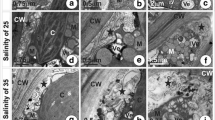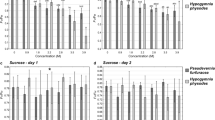Abstract
Based on the fact that only high saline water irrigated to the shelterbelt along the Tarim Desert Highway, the experiment about three species with six degree of salinity was carried out to analyze the relation between chlorophyll content and salt stress. The results show that: (1) the chlorophyll content of tree species decreases with aggravating the salt stress, which explains that salt stress can affect chlorophyll accumulation of three plants; (2) from chlorophyll content with different salinity, the chlorophyll content of three shrubs also has twice obvious decrease, which indicates that some plants adapt to salt stress. We divided salt resistance of the plant into three grades, namely the slight salt resistance, the heavy salt resistance and the extreme salt resistance; and (3) according to the experimental results, the salt stress of each plant was divided, which can provide theoretical guidance for constructing the shelterbelt along the Tarim Desert Highway.
Similar content being viewed by others
References
Hanson A D, Nelson C E, Pedersen A R, et al. Capacity for proline accumulation during water stress in barley and its implications for breeding for drough tresistance. Crop Sci, 1979, 19: 489–493
Moftah A E, Michel B E. The effect of sodium chloride on solute potential and proline accumulation in soybean leaves. Plant Physiol, 1987, 83: 238–240
Story R, Wyn J R G. Respondes of Atriplex spongiosa and Suaeda maritimeto salinity. Plant Physiol, 1979, 63: 156–162
Mccue K F, Hanson A D. Drought and salt tolerance: towards under standing and application. Trends Biotech, 1990, 8: 358–362
Bohnert H J, Jensen R G. Strategies for engineering water stress tolerance in plants. Trends Biotech, 1996, 14: 89–95
Kishor P B K, Hong Z, Miao G H, et al. Over expression of Δ1-pyrroline-5-carboxylate synthetase increases proline products and confers osmo tolerance in transgenic plants. Plant Physiol, 1995, 108: 1387–1394
Rao G G, Rao G R. Pigment composition and chlorophyyase activity in pigment pea and Gingelley under NACL salinity. Indian J Exp Biol, 1986, 19: 768–770
Carter D R, Cheeseman J M. The effect of external NACL on thylakoid stacking in lettuce plants. Plant cell Environ, 1993, 16: 215–222
Xu X M, Ye H C, Li G F. Progress in research of plant tolerance to salinestress (in Chinese). Chin J Appl Environ Biol, 2000, 6(4): 379–387
Zhao S J, Meng Q W, Xu C C, et al. Analysis of the Xanthophy cycle components in plant tissue by high performance liquid chromatography (in Chinese). Plant Physiol Commun, 1995, 31(6): 438–442
Strongonov B P. Structure and Fnction of Plant Cell in Saline Habitats. New York: Halsted Press, 1973. 25–95
Author information
Authors and Affiliations
Corresponding author
Additional information
Supported by Major Orientation Foundation of the CAS Innovation Program (Grant No. KZCX3-SW-342), CAS Action-Plan for West Development (Grant No. KZCX2-XB2-13), Major Scientific and Technological Special of Xinjiang Uygur Autonomous Region (Grant No. 200733144-3), and the research projects of the Tarim Branch of PetroChina Company Limited (Grant Nos. 971008090016 and 971008090017)
About this article
Cite this article
Xu, X., Xu, H., Wang, Y. et al. The effect of salt stress on the chlorophyll level of the main sand-binding plants in the shelterbelt along the Tarim Desert Highway. Chin. Sci. Bull. 53 (Suppl 2), 109–111 (2008). https://doi.org/10.1007/s11434-008-6012-5
Received:
Accepted:
Published:
Issue Date:
DOI: https://doi.org/10.1007/s11434-008-6012-5




